by Ocean Robbins: Root vegetables often make a cameo appearance on holiday tables…
But for the rest of the year, out of sight can mean out of mind — and out of mouth. It’s time for these versatile, delicious, and nutritional powerhouses to come out of the ground and into the spotlight. In this article, we’ll look at the amazing variety of root vegetables, and explore many ways to get them into your meals.
Let’s hear it for the introverts of the vegetable world: the root vegetables! Quietly hiding their calories underground, these soft-spoken nutritional powerhouses are great additions to your diet any time of year. But there’s no better time to sample their goodness than during the fall and winter holiday season. What would a holiday feast be without nature’s gifts from the underground, such as fragrant mashed potatoes, shiny roasted carrots, and delicious yam pudding?
Root vegetables are often featured as a side dish, but you can prepare them in a myriad of ways. Many traditional recipes cancel out the nutritional benefits of potatoes and sweet potatoes by adding unhealthy ingredients; cooking or frying them in refined oil, drowning them in factory-farmed dairy, and loading them up with refined sugar (as if sweet potatoes aren’t already sweet enough for a casserole).
But root vegetables are highly nutritious and can be a healthy part of a whole foods, plant-based diet. Some can be eaten raw, and there are also ways to cook them that optimize the absorption of their nutrients.
In this article, I’ll introduce you to some of my favorite root vegetables (some you know well, and some might be strangers), go over their powerful health benefits, share some of the best ways to prepare and use them, and give you seven delicious root vegetable recipes to make the most of these unassuming nutritional champions.
What are Root Vegetables?
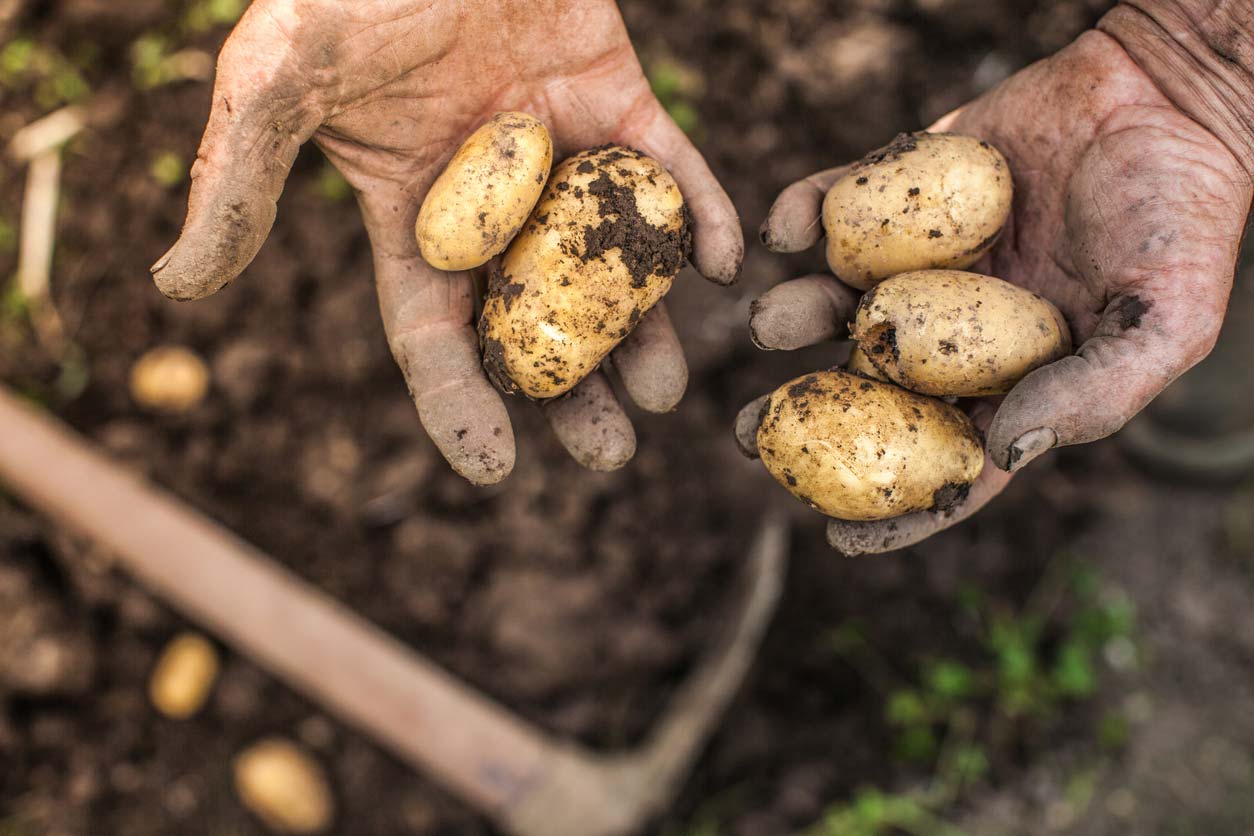
If people eat any part of the plant that grows beneath the soil, that plant is a root vegetable. Gardeners really like to dig (pun not intended, but I’ll take the bonus points anyway) into the details on this. Potatoes are tubers, while sweet potatoes are tuberous roots. Some roots are made of stem tissue as opposed to root tissue. And bulbs are different from corms. Feel free to geek out on your own; here’s a typical in-depth treatment of the subject by a Master Gardener.
For our purposes, let’s follow Food Revolution Summit speaker Ron Finley, aka the “Gangsta Gardener,” in classifying root vegetables into five major categories.
Tubers
First, you’ve got your tubers, which are basically underground storage units for the nutrients and water the plant will need to make it through the winter — or during a dry spell. Examples include potatoes, sweet potatoes, yams, Jerusalem artichokes, cassava, and jicama (pronounced HICK-a-mah).
Potatoes and other tubers are rich in antioxidants, such as vitamin C, and are full of resistant starch, which is a type of fiber that feeds our beneficial gut bacteria. This starch improves blood sugar control for those with type 2 diabetes, can treat and prevent constipation, decreases LDL cholesterol, and lowers the risk of colon cancer and digestive disorders. Potatoes and sweet potatoes also contain many minerals necessary for bone health, including calcium, magnesium, and zinc.
Taproots
Next, there are taproots, which grow straight down in one single structure, rather than the fibrous roots that look like tangled string. The taproots we like to eat also double as nutrient storage units, just like the tubers. Common taproot veggies include carrots, beets, parsnips, radishes, and turnips, as well as the turnip’s colorfully named relatives, kohlrabi and rutabaga. Because they grow straight down, some of the bigger ones can require some digging or strength to pull out of the ground — a fact that inspired the Russian fairy tale, “The Enormous Turnip.” Pro tip: if your turnip requires the combined effort of three humans, a dog, a cat, and a mouse to uproot, you should probably have harvested it sooner.
The colorful members of the taproot clan also boast high levels of antioxidants, including the beta carotene in carrots that’s famously good for eyesight, and a host of powerful compounds found in beets. Beets are also great for cardiovascular health, as they promote high levels of nitric oxide, which dilates blood vessels and helps lower blood pressure.
Rhizomes
The third category is the rhizomes, which store starches and proteins that allow plants to survive harsh seasons and return the following year. I learned a new word while researching this article, which I will share with you now: perennate. (Used in a sentence: “the ginger plant perennates in most US temperature zones and so will send up shoots every spring.”)
Rhizomes are pretty much the opposite of the taproots in that their roots travel horizontally in the soil, looking for bare spots from which to send up new shoots. Rhizomes tend to take over an area, as anyone who planted a single bamboo shoot and turned their back for 20 minutes has found out to their sorrow (or delight, depending on how they feel about a bamboo forest growing up at a rate of up to three feet per day). The rhizomes that make it onto our plates include the wonder-spices turmeric and ginger, and water plants like the lotus.
Ginger and turmeric represent the rhizome family fabulously in terms of health benefits. Ginger is a powerful antiviral, fights cancer, and aids digestion, among its many virtues. And I think it’s adorable that the name of its principal active ingredient is gingerol, which is far better for you than ginger ale. And it might take up less screen space to tell you what turmeric isn’t good for, rather than what it treats. From hacking our DNA to helping prevent cancer, dementia, diabetes, and autoimmune disease, to mending broken bones and soothing sore throats, the main active ingredient curcumin is one of the most promising phytonutrients that nutritional scientists have ever encountered.
True bulbs
Fourth, we’ve got the true bulbs, which include the mighty onion and its aromatic cousins shallots, leeks, ramps, and scallions, as well as the equally awesome garlic. It turns out that the layers of the onion, which are such a potent metaphor to the ogre Shrek, are actually composed of leaves that have adapted for the purpose of storing nutrients when the plant has gone dormant and stopped growing.
The bulb squad also features nutritional all-stars. Onions, garlic, and their kin are rich in organosulfur compounds, which have antioxidant, antiviral, and antibacterial properties. They’re also antimicrobial and contain high levels of quercetin, a natural antihistamine that has been shown to slow tumor growth, treat colon cancer, and reduce blood pressure.
Corms
Fifth are the corms, which look like bulbs but don’t grow in rings. Instead, they’re actually made up of stem tissue that’s modified to allow it to store nutrients. The corm veggies might not be so familiar to you, but many are staples around the world. They include taro (originally cultivated in Asia but now popular worldwide), water chestnut, malanga (a hairy-on-the-outside-starchy-on-the-inside vegetable that’s a big player in Caribbean, South American, and African cuisine), and the arrowhead (you might recognize it as a houseplant with arrow-shaped leaves, but it’s a great wild edible if you find yourself hungry and near a body of shallow water in North and Central America).
Corms like taro also boast significant health benefits. Taro is gluten-free, fiber-rich, and loaded with phenolic flavonoid compounds that support healthy skin and vision — and protect against certain cancers. It also contains a full complex of B-vitamins, as well as trace amounts of essential minerals.
When to Harvest Root Vegetables
Some of these root vegetables are available year-round, but the peak season in many climates is fall through spring. Some varieties get sweeter the longer they’re kept in the ground during cold weather, as the low temperatures challenge them to convert starch into sugar, which acts as a natural antifreeze and prevents cell damage. Parsnips are a great example. Once the ground freezes, these oft-maligned veggies become far sweeter. If you’ve never tasted a cooked parsnip that was pulled (or dug) out of frozen ground, you truly have no idea how delicious a parsnip can be.
Many varieties of root veggies are treated as winter vegetables since they can keep for long periods of time in cold storage (like a root cellar or refrigerator) during the colder months. But if you don’t have your own root cellar or walk-in refrigerator, you can still keep your root vegetables fresh and delicious all winter long. Here’s a comprehensive article on how to store the most common root veggies without having to use electricity. (Beware: some of the recommended strategies double as very strange house decorating tips, like hanging your garlic bulbs from the ceiling with old pantyhose.)
If you want to preserve your root veggies by canning, fermenting, or pickling, here’s a detailed tutorial that we put together to guide you.
Why Eat Root Vegetables?
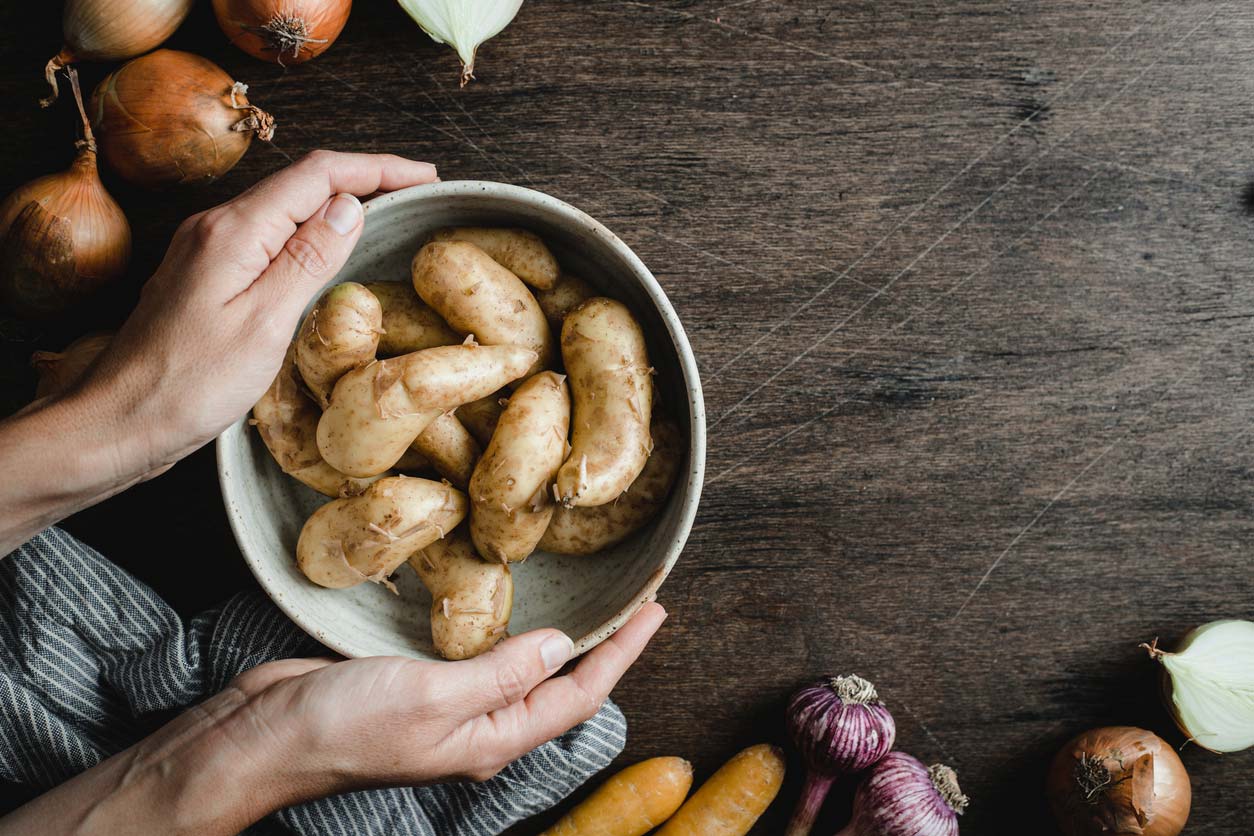
Root vegetables are super-nutritious. Think about it: the plant took great effort to store all these nutrients in its root to help it survive a rough winter. When we eat the root, we’re benefiting from all that concentrated goodness.
Root vegetables in general are high in B vitamins and minerals such as potassium, manganese, and magnesium. They’re high in fiber and full of one of the healthiest forms of starch, the resistant kind that the helpful critters in our gut love so much.
Root vegetables are sometimes vilified by keto and Paleo advocates because they have a higher starch and carbohydrate content than other vegetables. Fortunately, these are good carbs, completely unlike the processed carbohydrates from white flour and sugar that make up the bulk of starch consumption in the western diet. That said, the high carbohydrate percentage in certain root veggies can lead to rapid increases in blood sugar for some people. The magnitude of this effect depends on the eater’s sensitivity, combined with the glycemic load of the food — a measure of how fast and how much it affects blood glucose levels. The glycemic load is more accurate than the glycemic index in predicting how your body will process the sugars in a given food.
How to Cook & Use Root Vegetables
The health benefits you get from root vegetables depends largely on how you cook them. This is particularly clear when we look at potatoes. Consuming fried potatoes two or three times a week can actually double your risk of death. Slathering them in sour cream, cheese, and butter can likewise compromise your health. But baked, steamed, boiled, or air-fried potatoes eaten with other whole foods can reduce the risk of obesity and chronic disease.
Sweet potatoes in particular are amazing sources of nutrients as long as you prepare them in a healthy fashion. The traditional diet of the Japanese island of Okinawa, whose inhabitants are among the world’s healthiest and longest-lived peoples, derives over 60% of its calories from a single variety of sweet potato.
Healthy Ways to Prepare Root Vegetables
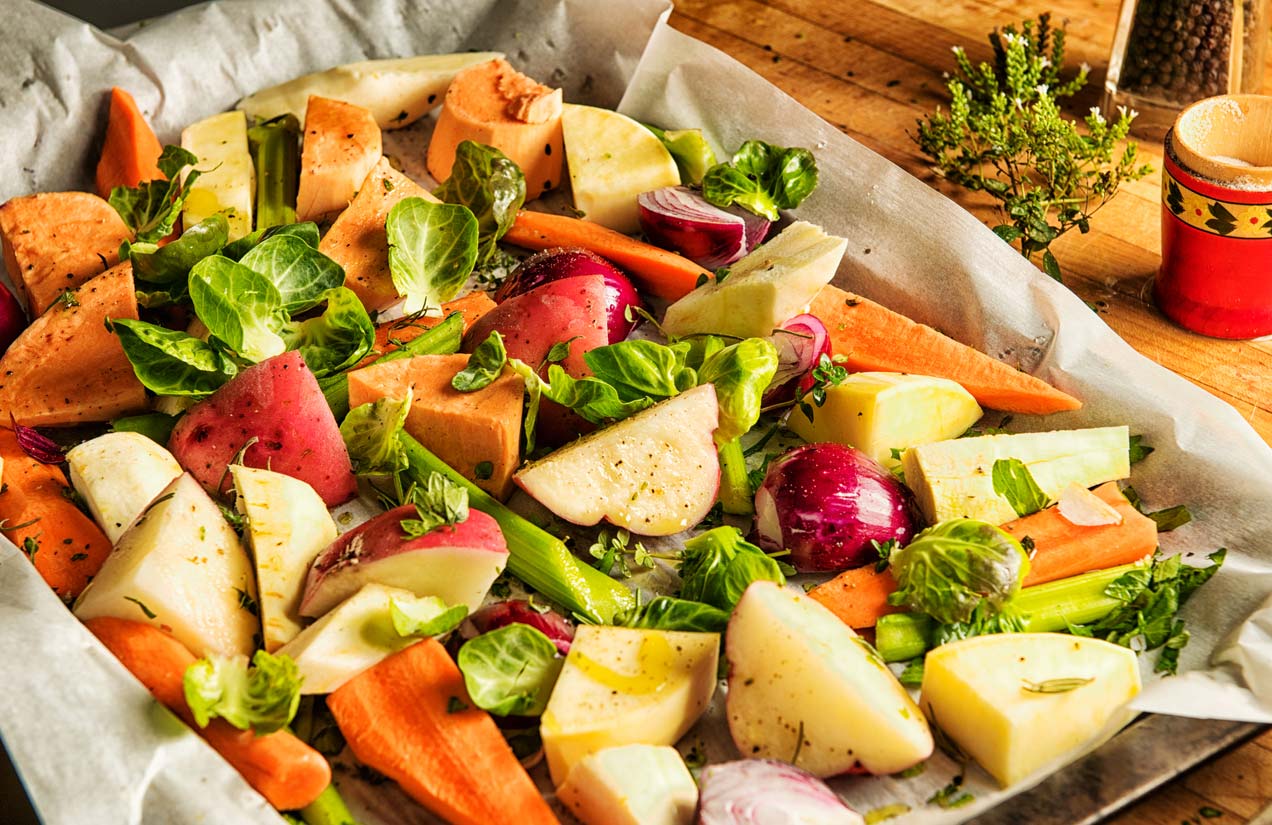
Baking
Baking converts some of the starch in root vegetables into sugars, making the calories more available, but also increasing the glycemic load. In the case of beets, a 2012 study of athletic performance found that baked beets enhanced the athletic performance of the study subjects
Boiling
Researchers at the Czech University of Life Sciences in Prague spent a lot of time in 2013 cooking varieties of potatoes in different ways and comparing their nutritional profiles. This work, which I like to visualize involving white coats, blackboards with complex equations, and people popping boiled potatoes into their mouths and shouting “Eureka,” determined that boiling retained more nutrients than baking or microwaving. Further, the researchers found that the red and purple varieties retained more antioxidants than the white or yellow ones. Keep the skins when boiling potatoes, as that’s where a lot of the nutrients are.
Steaming
Steaming is a lot like boiling, with a couple of advantages. Because you need less water, you use less cooking energy. Steaming is also quicker, and since the potatoes are not immersed in water, it retains more water-soluble antioxidants.
Microwaving
Microwaving also keeps nutrient levels high for the brassica roots, including turnips, according to 2019 research out of Gorgan University in Iran. After comparing the nutritional value of turnips subjected to a number of cooking methods, as well as canning, freezing, and sterilizing, the researchers found that microwaving and steaming for a short time were the two methods that minimized antioxidant breakdown and leakage. If you’re curious about whether or not microwaves are safe for cooking, check out our article here.
Roasting
Roasting is another method of applying heat to root vegetables that can mimic the crunch and flavor of deep-frying, but without the oil and high heat.
Stir-Frying
Stir-frying certain root vegetables has been shown to make some nutrients more bioavailable. For example, a 2012 study found that stir-fried carrots delivered 75% more retinol than raw ones. This makes sense, since retinol is fat-soluble, and therefore binds to the cooking oil used for the stir-fry. (If you’re cooking with oil, you might want to aim for olive or avocado oil. More on the pros and cons here.)
Slow Cooking
Cooking root vegetables in a slow cooker is a great way to blend their flavors with other ingredients. Roots like celeriac (celery root), rutabaga, and parsnip are favorites in dishes like minestrone and other thick soups and stews.
Blanching
Blanching is when you cook a vegetable for a short time in boiling water, then plunge that vegetable into cold or ice water immediately afterward to stop the cooking process. From a 2016 study based in Sri Lanka, we discovered that blanched yams retained 40% of the antioxidant anthocyanin and 64% of the total phenolic compounds.
Not all roots need to be cooked. Many can be eaten raw, including onion, garlic, jicama, ginger, carrots, and radishes. Others, like beets, can be eaten raw, though most people prefer them cooked. And yet others, like potatoes and taro, must be cooked before consuming to render toxic compounds harmless.
How to Use Root Vegetables
There are many ways to add root vegetables to your diet. In addition to those iconic holiday side dishes, you can also chop them into soups and stews; as well as bake, boil, or microwave and then mash or hash them. Many roots are great as chips or fries, baked or air-fried without oil. You can add them to salads, either cooked or raw. Carrots, beets, and radishes are classic salad roots. The starchy tubers make an excellent base or replacement for grains, especially if you want to avoid gluten and rice. And slicing them into stir-fries can add flavor, texture, and calories while making some of the fat-soluble nutrients more bioavailable.
Root Vegetable Recipes
Give a cheer for root vegetables — not just because of their nutrient value, but also because of the diversity they bring to your culinary life. Whether you’re looking for a flavorful dressing; a crunchy, oil-free snack; an inspired side; a perfect-for-Sunday main dish; a tasty sandwich or wrap filling; a quick-to-make sweet treat; or, a fortifying tonic, our root vegetable recipes are sure to satisfy. Root root, hooray!
1. My Heart Beets Dressing

Love beets? Then you’ll adore this dressing. Not so much? This dressing might just change your mind. Beet’s earthy flavor is balanced by the tang, sweetness, and acidity of the other plant-based ingredients. Beets are a good source of fiber, folate, and vitamin C. And this dressing is an easy way to benefit from those essential nutrients by using it on salads, grain bowls, wraps, and steamed vegetables.
2. Oven-Baked Onion Rings
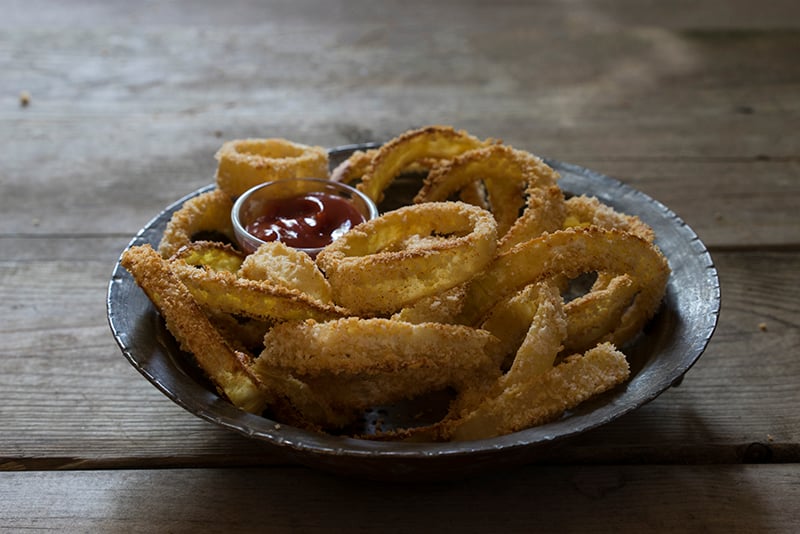
This fun dish is proof that you can create a crispy and crunchy snack without oil or frying. Serve baked onions as an appetizer at your small holiday gathering or alongside baked tofu and veggies. Each crunchy bite includes a nice dose of prebiotics and antimicrobial compounds.
3. Yuca Con Mojo
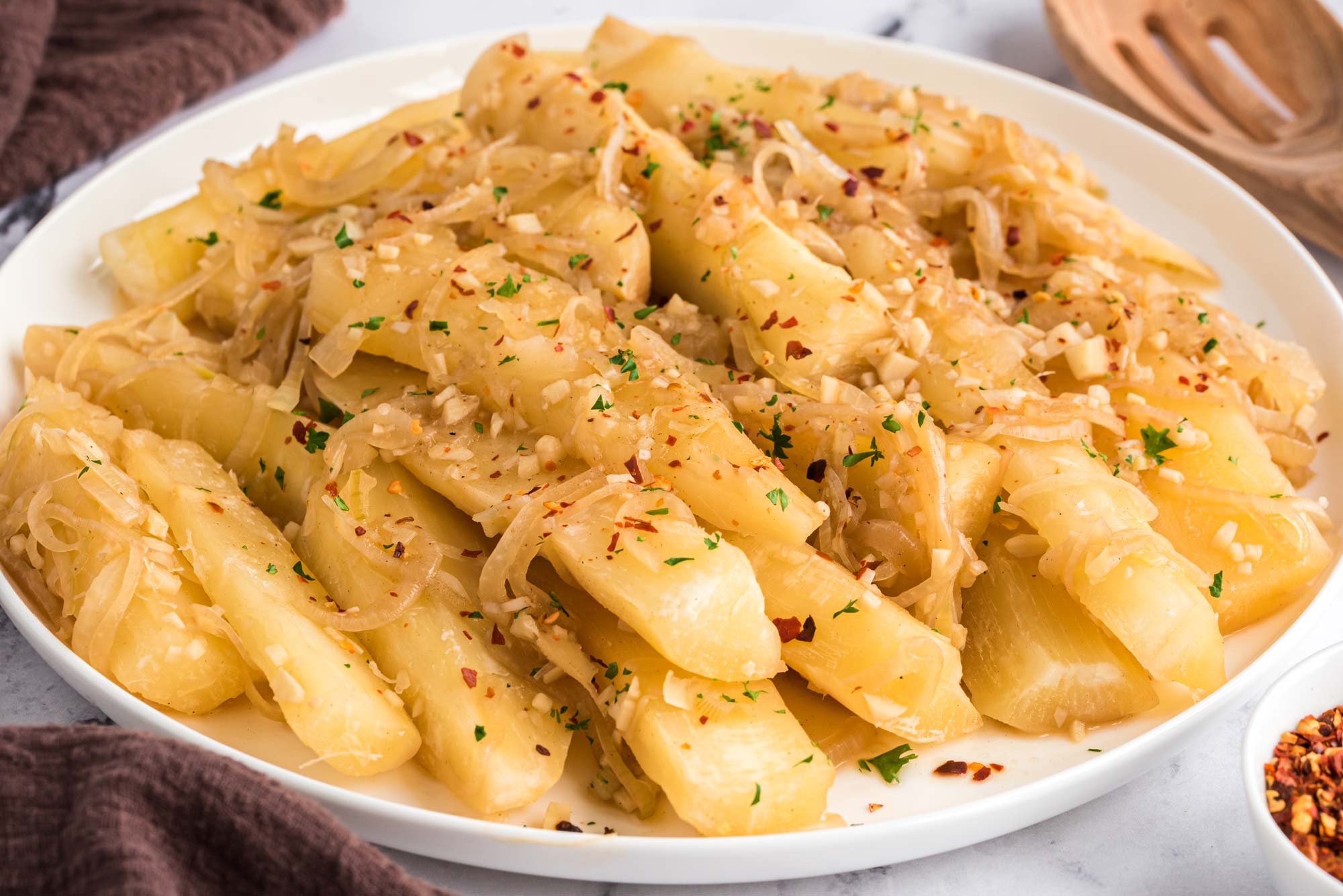
If you haven’t tried this Cuban staple yet, you’re in for a treat. Traditionally, it’s made by marinating yuca, or cassava, in garlic, lime, and oil. Variations include orange, lemon, or an orange-lemon juice combination in place of the lime. We went with lemon, as well as vegetable broth in place of the oil. No matter which marinade flavors you use, appreciate this lesser-known vegetable and its cultural roots (pun intended).
4. Lentil Stuffed Sweet Potatoes

Can we give a round of applause for sweet potatoes? Chock-full of carotenoids, vitamin C, B vitamins, and fiber, this naturally sweet root vegetable is also incredibly versatile. Use it as a base for soup, in stir-fries, as a veggie burger, or, in the case of this root vegetable recipe, as a boat for other nutritious foods! Adding the tahini sauce on top provides a plant-based fat source to help transport those healing fat-soluble vitamins.
5. Potato Meets Egg Salad
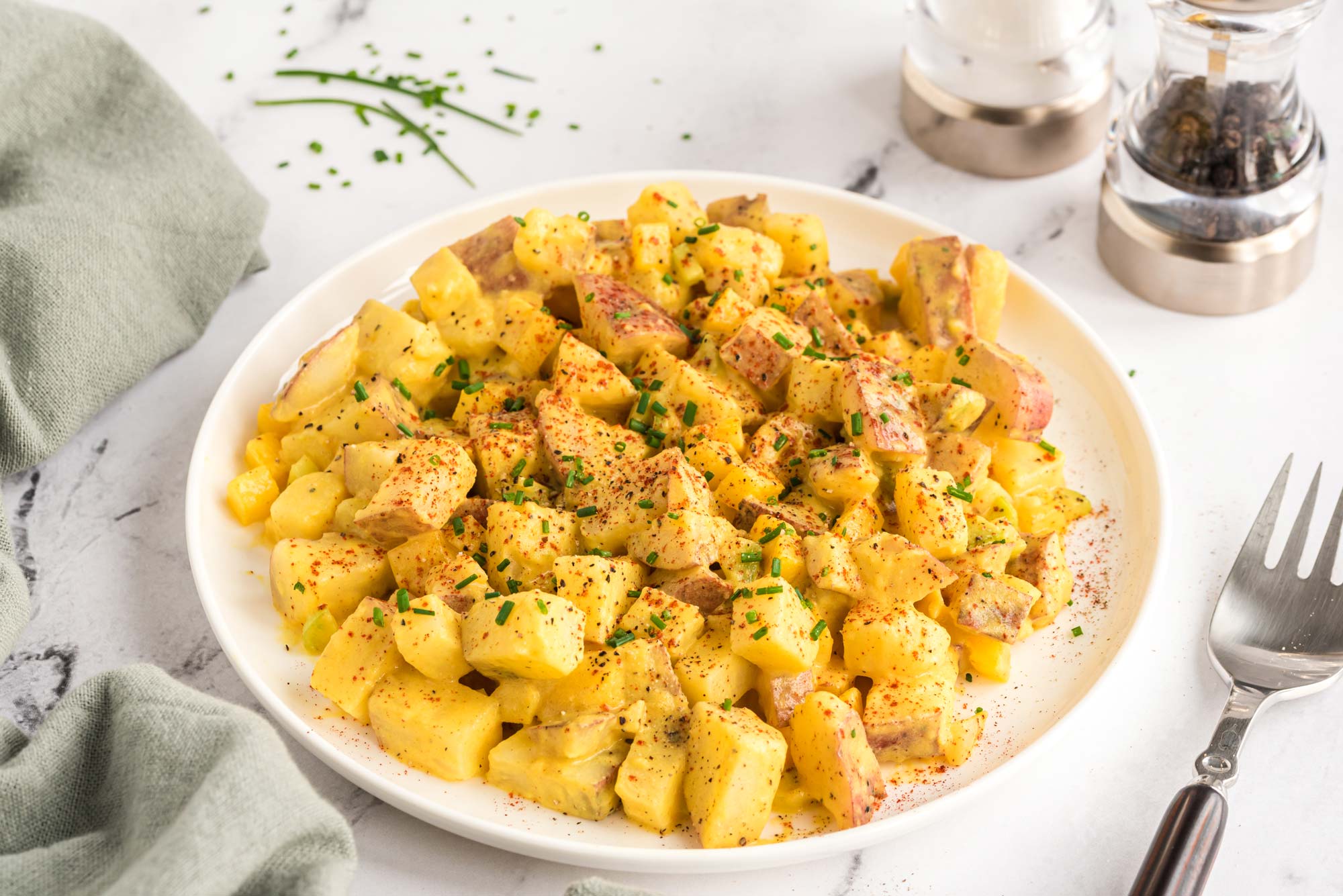
Potatoes take the place of eggs in this “egg salad,” adding fiber and vitamin C (eggs don’t have either), not to mention a special type of prebiotic fiber that’s good for your gut. Make this into a sandwich, serve as a side, or eat as a snack that both you and your (healthy) gut bacteria will love!
6. Carrot Cake Bites
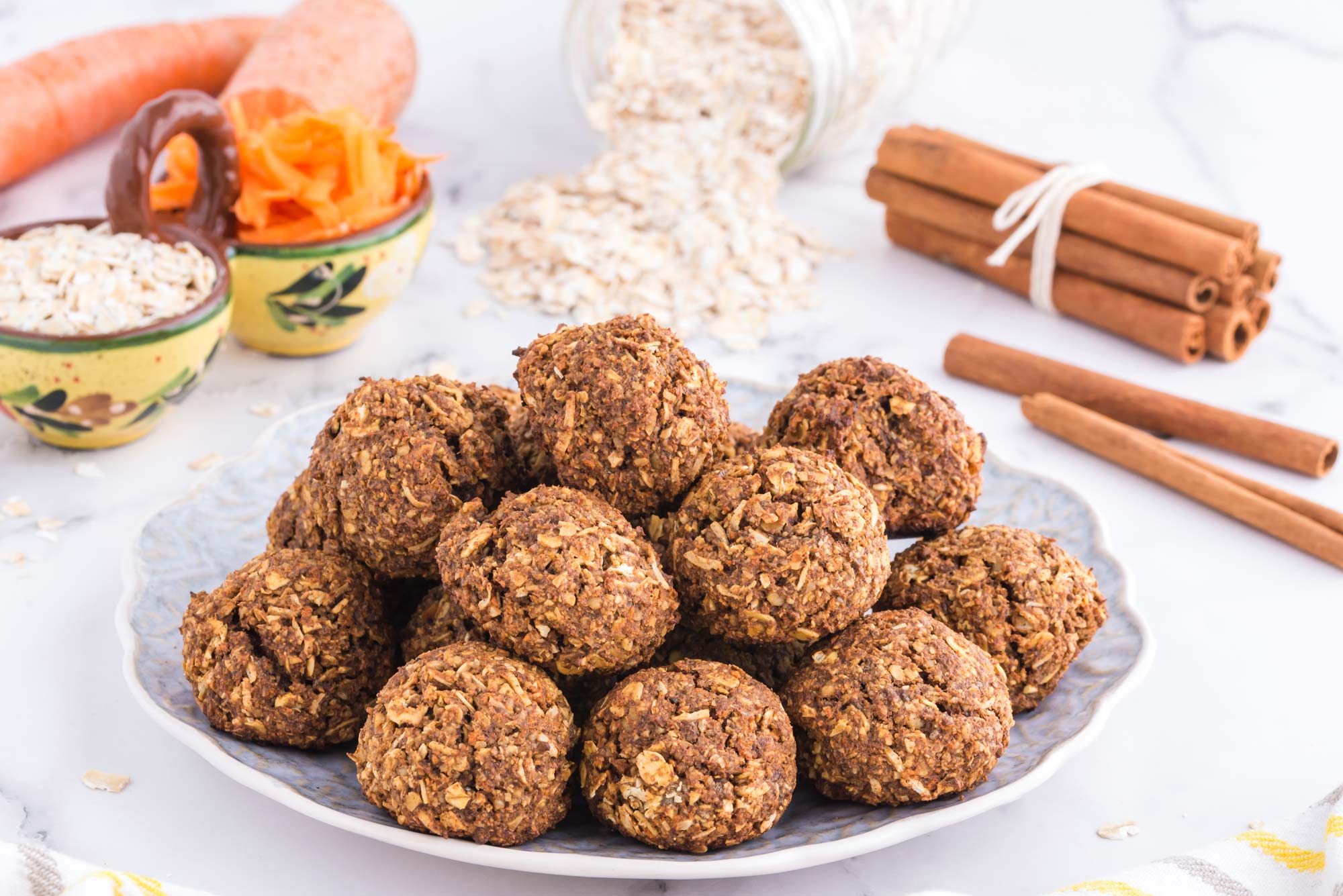
Here, carrots magically transform into tasty, itty bitty cakes (the healthy version of course, and ok, it’s not really magic). Probably best known for their vitamin A content (in the form of beta carotene) and their contribution to eye health, carrots have also been associated with weight loss and lower cholesterol since they’re low in calories and packed with fiber content and antioxidants. Carrot Cake Bites can be enjoyed raw or baked as a snack, breakfast, or dessert.
7. FRN’s Fire Cider
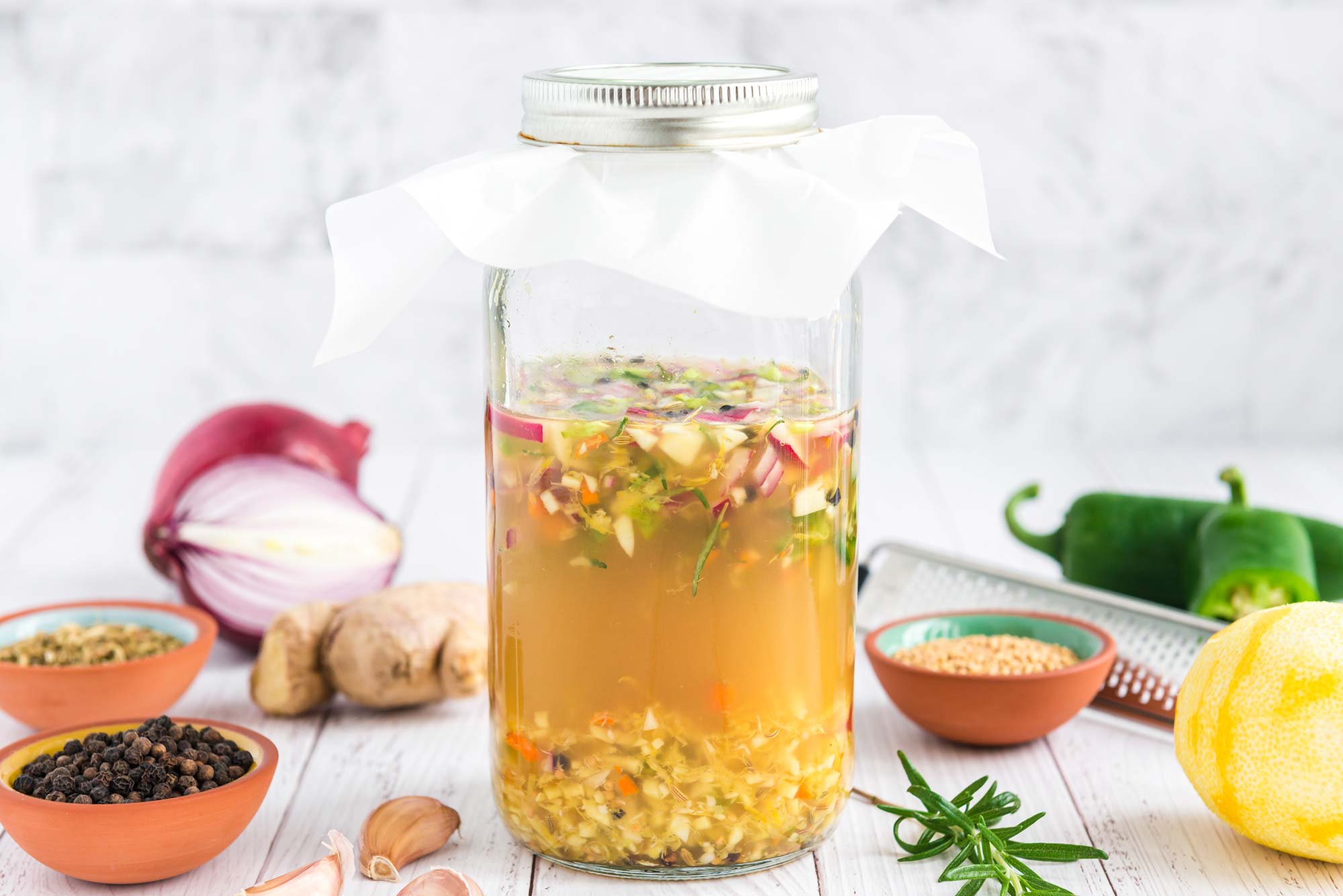
Want a bunch of root vegetables in just one place? Look no further than Food Revolution’s Fire Cider, which includes ginger, turmeric, onion, garlic, and horseradish root. These root vegetables have their own unique phytonutrients that contribute to their growth underground and to your health when consumed. Enjoy an ounce a day as an invigorating tonic.
So, That’s What You Need to Know About Root Vegetables

Root vegetables are incredibly versatile and nutritious additions to your diet, during the holiday season and every day. Most varieties can be eaten raw or cooked. You can use them in a lot of different ways, from side dishes to main courses, or tossed in with other vegetables in a variety of meals. Enjoy these recipes when you’re craving a hearty meal or satiating appetizer. Root veggies’ starch and fiber content make them a filling and comforting food choice, particularly during the winter months when most varieties are in season and at their sweetest.














































